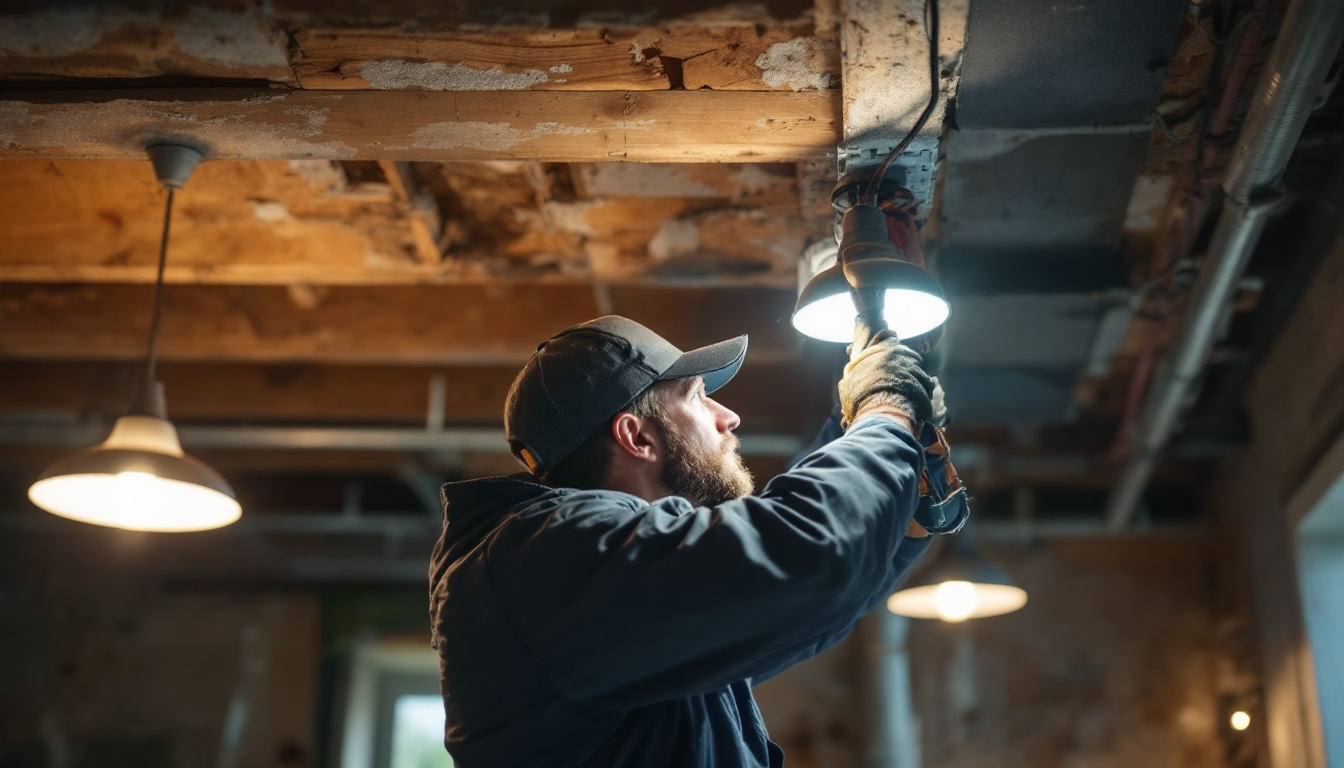
In the ever-evolving world of lighting technology, the transition to LED lighting has become a prominent focus for many contractors. The benefits of LED retrofitting are substantial, including energy efficiency, longevity, and reduced maintenance costs. However, navigating the complexities of a retrofit project can be fraught with challenges. This article aims to provide valuable insights for lighting contractors looking to avoid costly mistakes during LED retrofit projects.
Before diving into the intricacies of LED retrofitting, it is crucial to understand what it entails. An LED retrofit involves replacing existing light fixtures or bulbs with LED alternatives. This process can significantly enhance lighting quality while reducing energy consumption. The transition to LED technology not only modernizes the aesthetic of a space but also aligns with sustainability goals, making it a popular choice for both residential and commercial applications.
LED lighting offers numerous advantages over traditional incandescent and fluorescent options. One of the most notable benefits is energy efficiency; LEDs consume significantly less power, leading to lower electricity bills. Furthermore, they have a longer lifespan, often lasting up to 25 times longer than traditional bulbs, which translates to reduced replacement costs and less waste. This longevity is particularly beneficial in commercial settings, where the cost of labor and downtime associated with changing bulbs can add up quickly.
Additionally, LEDs provide better light quality, with options for adjustable color temperatures and improved color rendering. This versatility allows contractors to create tailored lighting solutions that meet the specific needs of various spaces. For instance, warmer tones can enhance the ambiance in restaurants and homes, while cooler tones are ideal for workspaces that require focus and clarity. Moreover, the instant-on feature of LEDs eliminates the warm-up time associated with fluorescent lights, providing immediate illumination when needed.
Before embarking on an LED retrofit project, several factors must be considered. First, it is essential to assess the existing lighting infrastructure. Understanding the current setup will help determine the most effective approach for the retrofit. This assessment should include evaluating the types of fixtures in use, their locations, and how they contribute to the overall lighting design of the space.
Another critical consideration is the compatibility of new LED fixtures with existing dimming systems or controls. Not all LED products are designed to work seamlessly with older systems, which can lead to flickering or inadequate performance. Additionally, it’s important to consider the potential need for new wiring or fixtures to accommodate the LED technology, as some retrofits may require modifications to ensure optimal performance. Consulting with a lighting professional can provide valuable insights into the best practices for a successful retrofit, ensuring that the transition is both efficient and effective.
While the benefits of LED retrofitting are clear, many contractors fall into common traps that can lead to costly mistakes. Awareness of these pitfalls is the first step toward ensuring a successful project.
One of the most significant errors is failing to conduct a comprehensive site assessment. A thorough evaluation of the space, including the layout, existing fixtures, and lighting needs, is essential for selecting the right LED solutions. Skipping this step can result in inadequate lighting levels or poor fixture placement.
Contractors should also consider the specific requirements of the space, such as the type of activities taking place and the desired ambiance. This understanding can guide the selection of appropriate fixtures and controls. For instance, a retail environment may benefit from brighter, more focused lighting to highlight products, while a restaurant might require softer, warmer tones to create a cozy atmosphere. Additionally, understanding the natural light sources and how they interact with artificial lighting can further enhance the overall lighting design.
Another common mistake is selecting LED products without fully understanding their specifications. Not all LEDs are created equal, and variations in quality, efficiency, and compatibility can lead to subpar performance. Contractors should prioritize reputable manufacturers and verify product certifications to ensure reliability.
Additionally, it is crucial to consider factors such as lumen output, color temperature, and beam angle when choosing LED fixtures. These specifications will impact the overall effectiveness of the lighting design. For example, a higher lumen output may be necessary for areas requiring bright, focused light, such as workspaces or garages, while lower outputs may suffice for hallways or ambient lighting. Furthermore, understanding the difference between warm white and cool white lighting can help create the desired mood and functionality in various settings.
Many contractors overlook available energy efficiency incentives, which can significantly offset the costs of LED retrofitting. Various utility companies and government programs offer rebates and incentives for upgrading to energy-efficient lighting solutions. Failing to explore these options can lead to unnecessary expenses and missed opportunities for savings.
Contractors should stay informed about local and federal programs that support energy-efficient upgrades. This knowledge can enhance project budgets and provide clients with additional reasons to invest in LED technology. Moreover, engaging with utility companies early in the project can help identify potential savings and streamline the application process for rebates. By leveraging these incentives, contractors not only reduce costs but also contribute to a more sustainable future, aligning with the growing trend of eco-conscious building practices.
To ensure a successful LED retrofit project, contractors should adopt best practices that promote efficiency and effectiveness. Implementing these strategies can help avoid common pitfalls and enhance overall project outcomes.
Effective communication with clients is paramount throughout the retrofit process. Engaging with clients early in the project allows for a better understanding of their needs and preferences. Regular updates and discussions can help manage expectations and address any concerns that may arise.
By involving clients in the decision-making process, contractors can ensure that the final lighting solution aligns with their vision. This collaborative approach fosters trust and satisfaction, leading to repeat business and referrals. Additionally, it provides an opportunity for contractors to educate clients about the benefits of LED technology, such as energy savings, longevity, and environmental impact. By highlighting these advantages, contractors can help clients appreciate the value of their investment, making them more likely to endorse the project to others.
Choosing high-quality LED products is essential for long-term success. While it may be tempting to opt for lower-cost options, investing in reputable brands can yield better performance and durability. Quality products often come with warranties and certifications, providing additional peace of mind for both contractors and clients.
Contractors should prioritize products that meet industry standards and have a proven track record. This diligence can prevent future issues and enhance the reputation of the contractor’s services. Furthermore, utilizing energy-efficient products can lead to significant cost savings over time, as clients will benefit from reduced energy bills and lower maintenance costs. By presenting a comprehensive analysis of the long-term financial benefits of quality LED products, contractors can further justify their investment choices to clients, reinforcing their commitment to excellence.
Training staff on the latest LED technologies and installation techniques is crucial for successful retrofits. A well-informed team can navigate the complexities of LED installations and troubleshoot potential issues effectively. Investing in training can lead to improved efficiency and reduced errors on the job site.
Additionally, keeping staff updated on emerging trends and technologies in the lighting industry can enhance the contractor’s competitive edge. Continuous education fosters innovation and helps contractors stay ahead of the curve. Workshops, seminars, and online courses can be valuable resources for staff development. Furthermore, encouraging a culture of knowledge sharing within the team can lead to collaborative problem-solving and the exchange of best practices, ultimately resulting in a more skilled workforce that can tackle diverse challenges in LED retrofitting projects.
Once the LED retrofit is complete, several post-project considerations can enhance the overall success of the installation. These steps ensure that the benefits of the retrofit are fully realized and maintained over time.
After the retrofit, conducting a post-installation evaluation is vital. This assessment should involve checking the performance of the new LED fixtures, ensuring they meet the expected lighting levels and quality. Any discrepancies should be addressed promptly to maintain client satisfaction.
Gathering feedback from clients about their experience with the new lighting can also provide valuable insights. This information can guide future projects and help contractors refine their approach to LED retrofitting.
Providing ongoing maintenance and support services can enhance client relationships and ensure the longevity of the LED installations. Regular maintenance checks can identify potential issues before they escalate, saving clients time and money in the long run.
Contractors should consider offering service agreements that include routine inspections and replacements as needed. This proactive approach not only benefits clients but also positions the contractor as a trusted partner in their lighting solutions.
LED retrofitting presents a valuable opportunity for lighting contractors to enhance their service offerings while providing clients with energy-efficient solutions. However, the complexities of such projects require careful planning and execution to avoid costly mistakes.
By understanding the fundamentals of LED retrofits, avoiding common pitfalls, and implementing best practices, contractors can ensure successful project outcomes. Engaging with clients, investing in quality products, and providing ongoing support are essential components of a thriving LED retrofit business.
As the lighting industry continues to evolve, staying informed and adaptable will be key to success. By embracing the potential of LED technology, contractors can lead the way in creating sustainable and efficient lighting solutions for a brighter future.
Ready to elevate your lighting projects and avoid the common pitfalls of LED retrofitting? Choose LumenWholesale for your lighting needs and experience the difference quality makes. Our spec-grade lighting products are designed to meet the highest industry standards, ensuring your projects shine with reliability and performance. With unbeatable wholesale prices and the convenience of free shipping on bulk orders, you can trust that you’re getting the best value without any hidden fees. Don’t compromise on quality or cost—visit Wholesale Lighting at the Best Value today and take the first step towards a brighter, more sustainable future with LumenWholesale.

Discover how lighting contractors can navigate the complexities of sourcing American-made light bulbs.

Discover how Lighting Behavior Services can revolutionize your contracting business.

Discover the essential insights on 8-foot LED lighting that every contractor needs to know.

Discover essential tips to steer clear of common pitfalls in lighting projects with our guide on light cans.